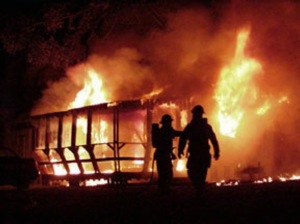
This week is the U.S. Fire Administration’s Arson Awareness Week.
As a former Assistant Secretary of Housing, I want to assure you that the patterns of fires related to areas of significant mortgage or other types of fraud are real. With the economy in recession and residential and commercial real estate values declining, it pays to be aware of arson risks. If your home, business or investment property is near or next to empty properties, please consider what actions you can take to safeguard your family, your colleagues and your assets.
If you live in an area with a volunteer fire, EMS and rescue association, keep them in mind as a group worth supporting. Here is their national association. For those of you with municipal services, you may want to check locally to see what they recommend for community support and education.
Read Arson for Profits
Excerpt: According to the National Fire Protection Association (NFPA), in 2005, an estimated 323,900 intentional fires reported to U.S. fire departments resulted in 490 civilian fire deaths, 3 firefighter on duty deaths (at the scene of, during response or return to, or from an intentional fire), 1,500 civilian fire injuries,7,600 firefighter on duty injuries (at the scene of an intentional fire but not including response/return injuries) and $1.102 billion in direct property damage.
The Federal Bureau of Investigation’s (FBI’s) 2007 Uniform Crime Reporting (UCR) statistics showed that 14,197 law enforcement agencies reported 64,332 arsons. Arsons involving structures (residential, storage, public, etc.) accounted for 42.9 percent of the total number of arson offenses. Mobile property (cars, motorcycles, etc.) was involved in 27.9 percent of arsons, and other types of property (such as crops, timber, fences, etc.) accounted for 29.2 percent of reported arsons.
The USFA’s National Fire Incident Reporting System (NFIRS) states the two leading causes of civilian deaths are arson, at 28 percent, and smoking, at 18 percent.

